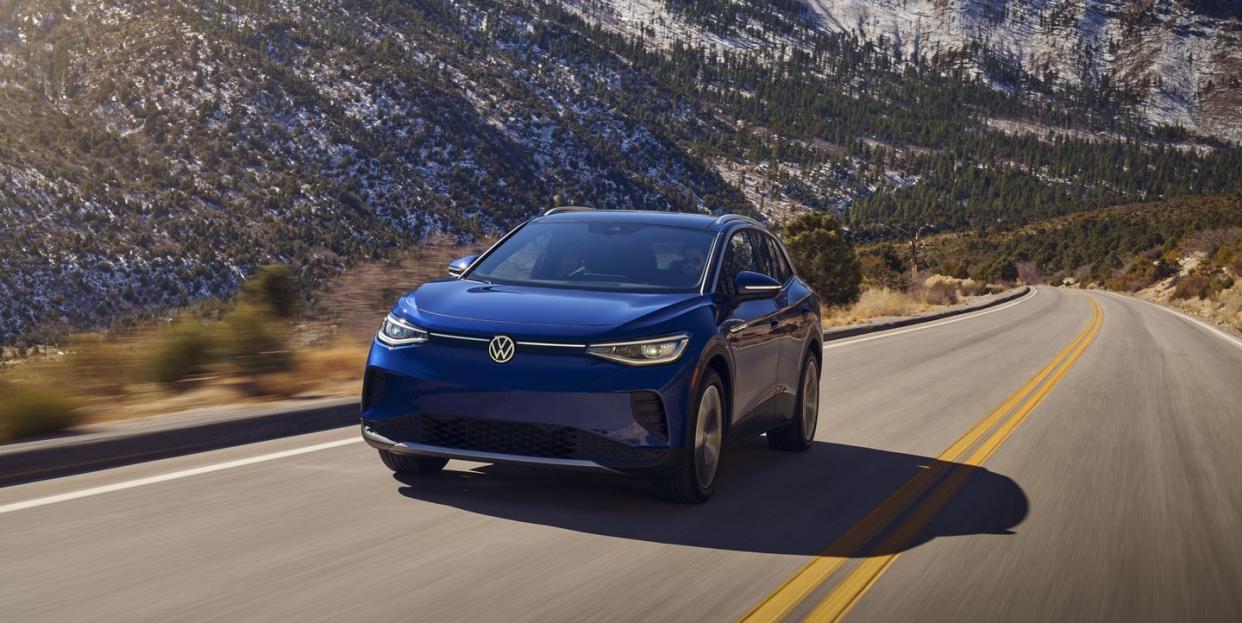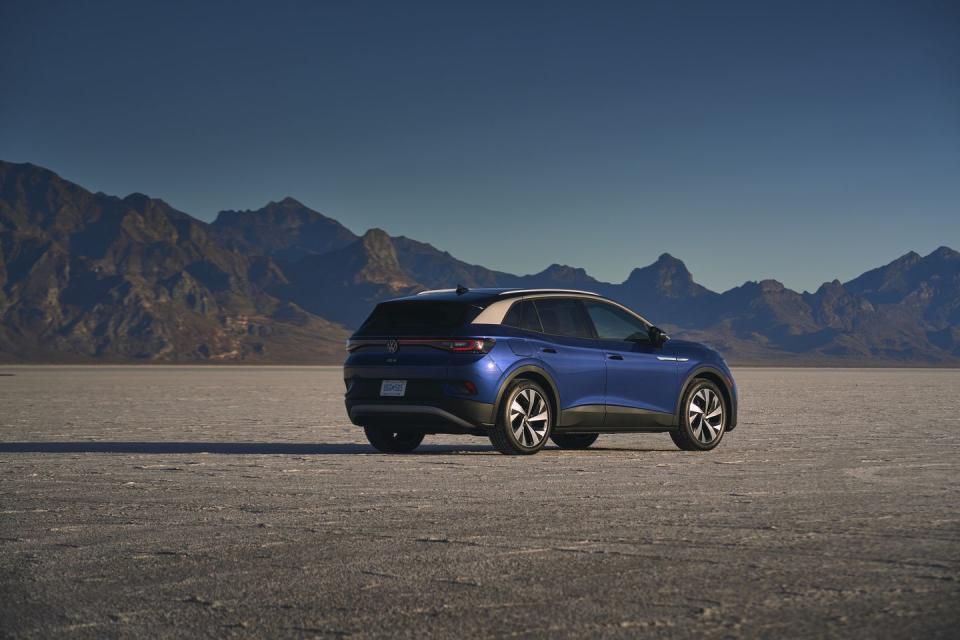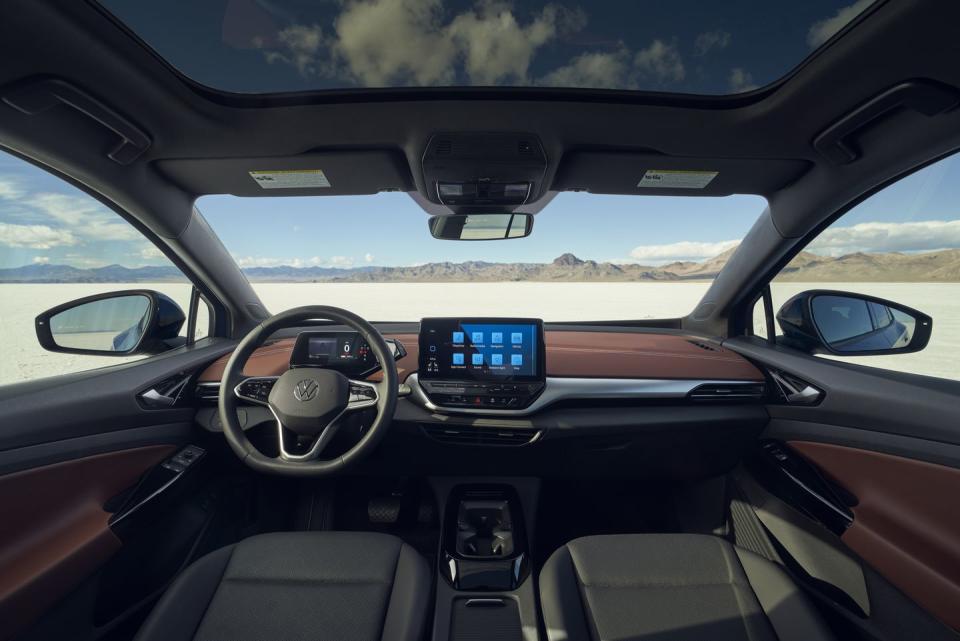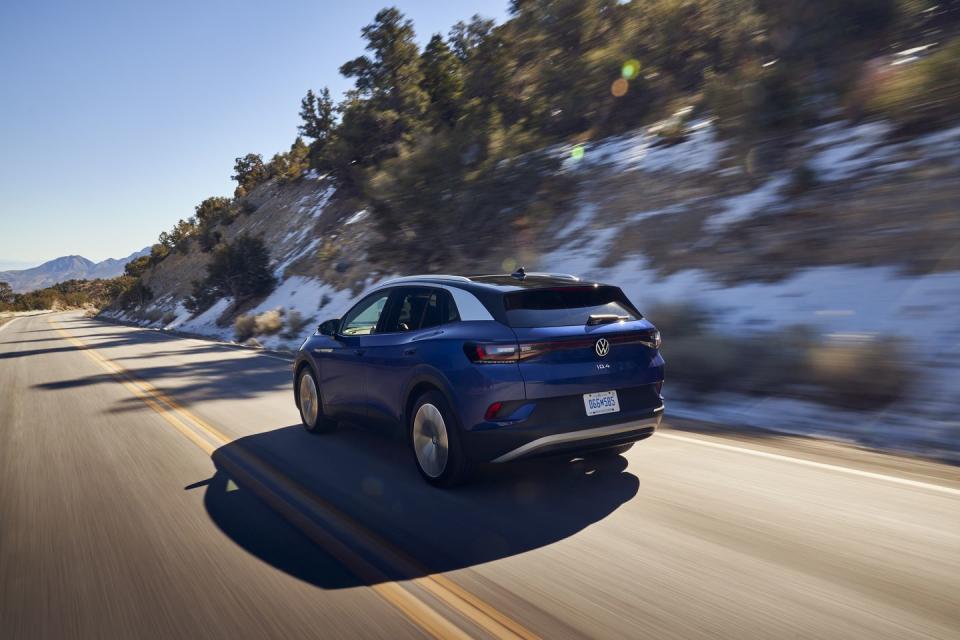The VW ID.4 Is a Bland Attempt at an Affordable Electric Crossover

The ID.4 may be America’s latest Great Green Hope, but Volkswagen isn’t promoting big-money fights with a Tesla Model Y or Ford Mustang Mach-E. Instead, VW urges us to view the electric ID.4 as a direct rival to unleaded-fueled SUVs like the Toyota RAV4 and Honda CR-V.
The implications seem clear: VW prefers to avoid uncomfortable conversations about the Tesla and the Ford, which comfortably top the ID.4 in performance, driving range, and dramatic screen-based tech. Secondly, VW believes the ID.4 can compete for the hearts and minds of Americans who buy more than 400,000 RAV4s in a good year, among some four million compact SUVs. For VW, and Ford and GM and every EV hopeful, the open question remains exactly how many of those millions are ready to be siphoned off and plugged in.
The ID.4 ably covers the practical side of the SUV equation. That includes reasonable affordability, via government subsidies to get the ID.4 within financial range of mega-selling gasoline SUVs, albeit just barely; a $41,190 base price becomes $33,690 after a $7,500 federal tax credit. Not coincidentally, that’s near the $33,000 that VW cites as the market sweet spot for a small gasoline SUV.

The VW’s official 250-mile driving range also proved to be a welcome case of truth in advertising, as the VW’s rear-mounted AC motor and 82-kWh battery pack had me on pace for about 270 miles while treading lightly. (We’ll see how Americans in northern climes feel about a rear-drive SUV). A dual-motor AWD version arrives later in 2021, with pricing that starts from $44,870 or $37,370 post-credit. That’s in line with the more lavish versions of the RAV4, CR-V, Mazda CX-5, or all-new Hyundai Santa Fe. For shoppers who actually do the math beyond monthly payments, the VW’s energy costs easily undercut any gasoline model or hybrid.
If anything ends up kneecapping the VW, it’s this: From styling to performance, the VW makes fewer waves than the Ever Given. Like the Chevy Bolt before it, a closer analog than many will care to admit, this crossover feels engineered to its electric price point. That’s no crime per se, especially with the automaking world on a Marshall Plan-mission to bring EVs into mainstream reach. But as I said at the Bolt’s launch, there’s no sense of “gotta have” in the ID.4’s exterior design, few surprises in its roomy, yet segment-predictable interior. VW performance junkies may be especially disappointed. The ID.4 shrugs off any imperative to dazzle with on-road dynamics or Tesla-baiting acceleration.
The big-tent philosophy seems to extend to the ID.4’s launch strategy. Where many EV makers (Porsche, Hummer, Lucid) shoot from the gate with their priciest and most powerful AWD halo versions, Volkswagen’s opening salvo is a relative popgun. The single-motor 1st Edition brings 201 horsepower and 229 pound-feet of torque. It starts from $45,190, pre-incentives.
My first squeeze of the VW’s accelerator had me humming “Is That All There Is?” Yes, the ID.4’s 7.6-second run to 60 mph is on par with models like the CR-V, despite a 4,700-pound curb weight that tops the front-drive Honda by some 1,200 pounds. But a Mazda CX-5 Turbo clips 60 mph in 6.1 seconds and starts below $32,000.
Worse, the ID.4 is the hospital vichyssoise of electric steering and handling: Cold, soupy and bland. The low center of gravity of VW’s electric MEB platform helps keep things planted. But tire grip is modest, even on optional, 20-inch wheels with Bridgestone Alenza tires. And when those rear tires do lose traction, a trigger-happy stability control (which can’t be fully disabled) makes clear that the VW’s mission lies elsewhere. The driving experience may be cemetery-calm, but fun is DOA.
Forthcoming AWD models add $3,670 in return for the 302-hp dual-motor layout, which VW says will trim 0-60 mph sprints to less than six seconds. That’s more like it. The most-affordable ID.4 Pro with AWD starts from $44,870, or $49,370 in Pro S form. The latter verges on a 346-hp Mustang Mach-E Premium AWD at $50,800, which scorches 60 mph in 4.8 seconds and is more engaging to drive than the VW.
That said, the VW was peppy enough to execute crisp passes, especially in its selectable Sport mode, and to sail with mirror-flat ease on highways north of Manhattan. Styling brings the crossover cuteness with wavy bodywork, an illuminated front light bar and VW logo, flush-mounted door handles, and an available contrasting black roof with silver roof rails and C-pillars.

The interior is the modern mixed bag familiar to EVs. Minimalist aesthetics verge on bare-bones, especially compared with richly appointed gasoline models like the Mazda and Santa Fe. A 5.3-inch digital display atop the steering column (with an integrated shift toggle) replaces driver’s gauges, but feels stingy in appearance and information. The VW’s cantilevered center console with its sliding armrest looks cool. My ID.4 1st Edition brought loads of USBs and USB-c’s, plus a wireless charger. Another clever bit: Hop into the sensor-equipped driver’s seat, and the VW powers up the instant you press the brake. Unbuckle your belt and climb out, and systems shut down. A start/stop button turns on 12-volt accessories.
But please, EV designers, enough with the Apple-picking white trim, here including the dirt-prone steering wheel, door panels and screen surrounds; it felt played out even when Chevy was doing it. Fortunately, only 1st Editions come with the snowy trim, so if you love it, go for it.
More fun is ID Light, a strip of 54 multi-colored LEDs below the windshield with visual and audio prompts for navigation turns, charge status and other functions. No fun at all is VW’s 12-inch Discover Pro Max infotainment system, which is all the things you hate about touchscreens in one, from vexing screen layouts and too few physical buttons to an incompetent voice assistant that bungled even the simplest commands. Here, both the Tesla and Ford feel miles ahead of VW in screen size, presentations and intuitive operation. In the ID.4’s defense, haptic sliders for audio volume and cabin temperature actually work better than most of their ilk.
There’s ample room front and back, an airy feeling heightened by an available, nearly full-length fixed panoramic sunroof. Rear-seat legroom is on par with a RAV4, but trails the spacious CR-V by nearly three inches. Unlike many small SUVs, the VW’s rear seatback doesn’t recline or slide fore-and-aft. The VW brings a skosh more cargo space than the Mach-E, with 30.3 cubic feet behind the second row, 64.2 with rear seats folded. There’s plenty of storage cubbies, and additional storage below the cargo floor. Both a RAV4 and CR-V will swallow 20 percent more gear behind the back seats, with the Honda maintaining that 20-percent edge with seats folded.
The VW shines brightest in efficiency, charging and money-saving. I spent one two-hour highway stretch absolutely flogging the VW, including runs to its maximum 99-mph top speed. I was intentionally trying to sap its battery (with 77 usable kWh) prior to a charging stop, yet still found myself on pace for nearly 200 miles of range. An EPA rating of 97 mpge matches a rear-drive Mach-E, but pales before the Tesla’s Model Y Long Range’s 125 mpge. Two levels of regenerative braking include one that feels like coasting in a conventional car. A stronger “B” setting is beautifully tuned for liftoff deceleration, if not as one-pedal robust as some EV acolytes might prefer.
With precisely 50 miles of remaining range, I rolled into a Target store in Clifton, N.J. Six Electrify America chargers stand sentry there, with 12 total plugs, each offering 150 kilowatts of DC fast-charging power. VW estimates a charge from five-to-80 percent in 38 minutes at its maximum, 125-kilowatt rate; slower than a Porsche Taycan or Supercharging Tesla, but still snappy.
Once connected to the bulky DC cable, the VW’s 288 Panasonic pouch cells quickly filled with juice. An initial recharge rate of six miles per minute was right in line with company estimates. In 31 minutes the ID.4 replenished its battery from 20 to 80 percent, adding 140 miles of range. Those miles were on the house, as VW offers three years of free public charging at VW’s Electrify America stations, which are funded by VW’s court-ordered Dieselgate penance and offer nearly 600 locations and more than 2,400 DC fast chargers.
Using home electricity, the EPA expects an ID.4 owner to spend just $700 a year to cover 15,000 miles. That’s $1.14 in electricity for every 25 miles, half the cost of a typical new gasoline-powered model. That estimated $700 in annual energy costs compares with $1,050 for a 40-mpg RAV4 Hybrid, $1,400 for a front-drive CR-V, and $1,800 for the CX-5 Turbo. Serious savings, no matter how you slice it.

For now, every ID.4 is imported from Zwickau, Germany, the first of five planned ID.4 factories on three continents, including two in China and an expanded plant in Chattanooga, Tennessee, where VW intends to kick off U.S. production in 2022.
For those on the electric fence, the final lure is the $7,500 federal credit, plus more largesse in certain states. The post-credit price becomes $37,690 for the feature-stuffed 1st Edition; $37,370 for the most-affordable, 302-hp Pro AWD model; and $41,870 for a Pro S with AWD. Funny how a $7,500 discount can change one’s perspective on whether this VW offers reasonable value. Unless you were expecting an electric GTI.
You Might Also Like

